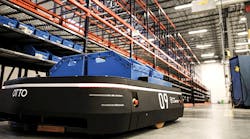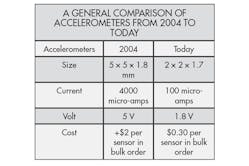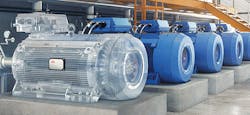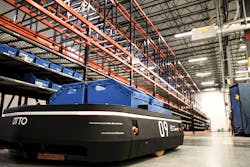This file type includes high-resolution graphics and schematics when applicable.
Just as an integral becomes more accurate as it increases its subintervals (the value of “n”), so can industrial processes through offering more data points. Traditionally, a technician might check gauges a few times a day, week, or month. However, if a gauge indicates that nothing is wrong, or it is within an acceptable range, the technician may not make a note of the gauge reading. Attaching a cost-effective sensor able to sample and record raw data multiple times per minute, hour, or day greatly increases the process’s “n” value. Aggregating more raw data points opens the door for statistical software and algorithms to translate raw data into process information to make maintenance or business decisions.
Automation company ABB says it’s the process information extracted from raw data that adds value. Through years of designing and testing motors, ABB has found key parameters to watch for in raw data to indicate properties that hinder performance.
“You need to know what the key condition indicators are for a process,” says Tom Bertheau, ABB product manager, condition monitoring. “Raw data alone doesn’t tell you anything. Through sensing, it is possible to aggregate raw data, which then uses algorithms and statistical software to communicate process information that tells a user that they might have a bearing or cooling problem.”For example, temperatures in a motor can increase due to varying loads on the shaft or voltage from the power supply. Installing a sensor package able to measure and communicate these variables not only alerts a technician that maintenance is needed, but will help troubleshoot a temperature problem. If voltages fluctuate within operating range, it wouldn’t be reason for alarm. However, if fluctuating temperature and power consumption presented a technician with a warning to pay closer attention to the input voltage, it may improve the motor’s lifecycle. Low voltage can increase the amperage of the motor, causing overheating. High voltage can push the magnets to a point of saturation that draws excessive current while not providing much benefit. In addition, while motors can handle some variation in voltage operating beyond these limits, high or low voltage, causes stress that often correlates to an increase in amperage and temperature, and a decrease in lifecycle.
While new machines are integrating sensing technology, older or legacy equipment may not have this ability. Some companies developed sensor packages that can retrofit to legacy equipment to solve this problem. However, knowing where to start is the question. Often, companies are slow to integrate because the cost to replace is high, and retrofitting may open a myriad of problems managers many not understand how to navigate.
Communicate the Benefits of Retrofitting
The first step toward retrofitting is for engineers and plant technicians to communicate to develop an IIoT plan with managers. A root-cause analysis for key information the company needs for maintenance plans or managerial decisions can reduce the amount of IIoT devices in a plan. This keeps the system more cost-effective and less complex. In some cases, it is possible to see that an IIoT device might have the greatest value by integrating it into a low-cost piece of equipment.
For example, low-voltage motors are popular for multiple reasons, but a big one is the price. Investing money to connect such an inexpensive piece of equipment, such as a low-voltage motor might seem pointless. However, “many customers used low-voltage motors,” said Bertheau. “We found roughly 50% of industrial energy goes into low-voltage motors and with an approximation of about 3 million motors in the field this represented a lot of power.” In areas where electricity is expensive, such as in Europe, ensuring these motors are running efficiently adds up. In addition, while the motors are cost-effective downtime for unscheduled maintenance can easily cost more than the motor. Now, the idea of investing money into an IIoT device for an inexpensive part sounds more logical.
ABB is offering sensing technology for low-voltage motors. In some of ABB’s tests with sensing technology, downtime was reduced up to 70%, and ABB estimates preventive maintenance will extend the life of the motor by 30%. Bertheau adds, “This data can be used to improve motor efficiency by 10%. Not completely through peak performance by ensuring it runs with good bearings and alignment, but by monitoring the power input and output. If you notice you are using more energy than you need, you could replace the motor with a smaller one that will use less energy. It might also be possible to modify the drive to be more efficient for the application.”
New motors can come with sensors built in, but there can be greater value in retrofitting, as there is little value in replacing working equipment. Informing technicians about bearings going bad through the process data can check inventory for the replacement parts needed for the job and schedule maintenance at a convenient time.
Interim Approaches
Many companies may not be ready to update equipment and PLCs with IIoT technology, but they still want the added benefits that connectivity can provide. This has led to branch technologies that use sensor packages with Bluetooth low energy and Wi-Fi. These new smart sensors and sensor packages may need to be wired and programmed into the existing control system or require a power source. But a trend is to offer sensing capabilities while being as independent as possible. Sensor packages are coming with batteries that will last for years and wireless links. As a result, with or without a system or infrastructure in place, it is possible to add connectivity to a process. This eliminates some of the concerns about utilities and patching in a new technology with a legacy technology.
“Ideally, enterprise information technology (IT) systems should include or accommodate architecture that is based on the Industrial Internet of Things (IIoT), which leverages internet protocol down to the sensor level,” says Erik Dellinger, manager for the IoT for Kepware. “While IIoT is gaining momentum, the reality today is that enterprise IT systems must interface with older technologies. Innovative suppliers are meeting this challenge with unique, easy-to-use, and cost-effective technology that enables cloud-based, Big Data solutions to collect and organize data. Called intelligent data aggregation, it revolutionizes the implementation of an enterprise system.”
This sensor-based approach reduces integration time and cost, but it can act independently or with current IIoT programs. For example, the Fujitsu components division recently teamed with Cratus, a sensor technology company, to offer sensor packages that can take advantage of the use of smartphones. “There has been a movement for companies to use employees’ personal cell phones for business purposes, whether it is for company email or installing an app for wireless communication,” says Bruce DeVisser, Fujitsu components product manager. “Technicians can document information by opening up an app on their phone and simply walk up to a device and use its Bluetooth or near-field communications (NFC) to update information.” A technician can have an app or dashboard on a smartphone that updates information when the technicians are in range and transmit this data to the internet through the Wi-Fi connection in the phone. Once the data is on the server, software is able to produce process information and send it wherever it is needed—even back to the technician’s phone.
Security Risks
However, simplifying access to equipment and information means it might be easier for the wrong person to access it. Security is also relatively simple with these types of sensor packages. If someone maliciously gains access to your system, a sensor package with this type of connection generally cannot change or impact the device being monitored. For example, a hacker can’t overload the sensor package to cause a motor to shut down. Hackers, if they could access the server, Wi-Fi, Bluetooth, etc., would only be able to see how much a company’s motor is vibrating. If it is possible to link this information into a feedback loop into a PLC program, there may be a chance for malicious acts. But most sensor packages, for now, seem to be focused around informing humans what might need to be changed or maintenance, not control of the machines themselves.
Adding RF
Another trend for wireless sensing is to offer remote control. Technically, devices that are controlled remotely might not need to be connected to the internet. Yet, connected RF devices can offer IIoT-like sensing and control. From welding to construction equipment, RF is able to connect, communicate, and control. This IIoT-like add-on is focusing on the same features as the previously mentioned trend—adding more information and possibly control with minimal capital and infrastructure.
Other wireless technologies are helping to reduce the infrastructure needed for connected devices. For example, self-driving robots can use photo, infrared, and touch sensors to navigate an environment. They may provide better or more efficient service by using light detection and ranging (LiDAR). LiDAR technology today is still relatively expensive, but advances have shrunk the technology to the point where it can be implemented directly on a circuit board. It also is available for a dramatically reduced price.
Impressively, self-driving robots can incorporate radio frequency, LiDAR, and cameras to “observe” and drive safely in an area. These technologies can take up computational power, but can’t interfere with the robot’s ability to drive. Self-driving robots wouldn’t be marketable if they crashed into things because they were buffering.
“We must do more with less,” said Simon Drexler, director of industrial solutions at Clearpath. “It isn’t enough to make a robot that can accomplish a task, it must show a return on investment or justify itself economically. One of the ways a material transporter, such as Clearpath’s OTTO, does this is not just by moving things independently, but offering extra data. The software allows the robot to give data on the most optimal paths and provide insight on how to improve operations. For example, if the most popular parts are at the back of the shop, the computer can suggest moving them to the front to save time.”
While mass production is reducing cost, providing in-house logistics, preventative maintenance, and more information to make decisions, IIoT technology is increasing its economic feasibility and companies need to be educated in this technology to stay competitive. When leveraging IIoT technology correctly, the question isn’t “will there be a return on investment?” but “how long will it take to get the return?” With new retrofit products, the time for a return on that investment is being reduced.
Looking for parts? Go to SourceSB.
This file type includes high-resolution graphics and schematics when applicable.




